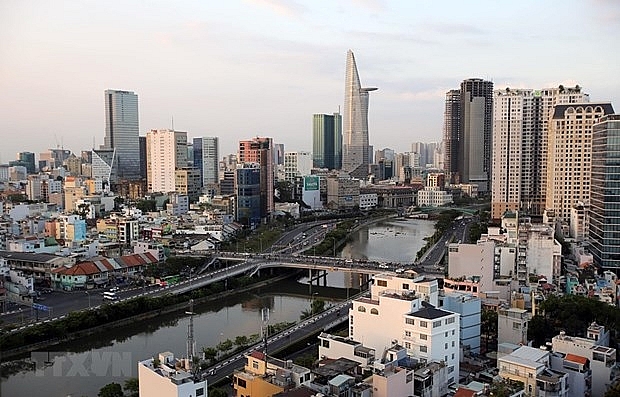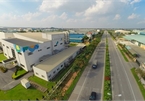 |
| A view of Ho Chi Minh City, an economic hub in the south of Vietnam (Photo: VNA) |
According to Pham Lam, general director of DKRA Vietnam, the three neighbouring provinces of Binh Duong, Dong Nai, and Long An just outside Ho Chi Minh City are those receiving the most interest from real estate developers and investors.
“Suburban provinces have a larger land fund with lower expenses for clearance and compensation, while the improvement of infrastructure is encouraging investors to come here,” Lam said.
With a strategic location linking Ho Chi Minh City and Mekong Delta provinces, Long An is one of the most sought-after destinations for property investors.
Thanks to many large-scale projects such as the completed Ho Chi Minh City-Trung Luong Expressway and N2 Highway, prospects are opening up for new initiatives outside the metropolis. Additionally, Ho Chi Minh City People’s Committee have plans to set up a third urban railway from Ben Thanh, District 1 to Tan Kien commune, Long An with the total investment capital of VND68 trillion ($2.95 billion).
In Dong Nai, a range of infrastructure projects have been set up to connect with Ho Chi Minh City. Outstanding projects include Metro Line 1, a road parallel to Ho Chi Minh City-Long Thanh Expressway, and Cat Lai Bridge linking Ho Chi Minh City with Dong Nai’s Nhon Trach district, as well as the upcoming Long Thanh International Airport.
Meanwhile, the new Pham Van Dong road connects with Tan Son Nhat and crosses Binh Duong to the eastern provinces.
The wave of decentralisation is considered to be a determining real estate investment trend in the coming years. Together with improving the infrastructure network, the real estate market in these provinces is also booming.
Dong Nai now features two giant developers – Novaland Group and Dat Xanh Group – both of which have large projects here.
In the first quarter the southern real estate market has seen short supply and Novaland reported positive sales in townhouses and villas in Aqua City – the first venture invested by Novaland under the ecological urban area concept.
The more than 600-hectare Aqua City in Dong Nai is regarded as the most remarkable project currently in the east of Ho Chi Minh City.
Dat Xanh, meanwhile, is developing a 92ha project near Long Thanh International Airport to offer total housing space of more than 4,000 villas for a population of more than 18,000.
In Long An, after launching the Vincom project in Tan An town, Vingroup has proposed to invest in a 900ha urban development area in Duc Hoa district. Many other giant developers such as Him Lam Land and Van Thinh Phat have submitted a range of proposals at Long An. Especially, Nam Long Group is developing the 355ha Waterpoint – a “riverside city” which will offer accommodation for around 30,000 residents.
Meanwhile, Binh Duong and especially Di An town boast many developers like Kim Oanh Real Estate, Sacom Land, Him Lam Land, and Phu Dong Real Estate, all of which have seized the opportunities and prepared ample land reserves for their projects.
Giant developers with long vision of development are expanding their land funds in suburban areas. Buyers with good finance are going to projects in suburban provinces for the green space and a high-quality living environment they offer.
For individual investors with limited finance, buying small land areas in suburban areas is also a reasonable option. Many investors have built workshops or rented rooms to local workers in industrial parks.
Despite suburban provinces drawing interest from both developers and buyers, experts warned that the road will remain bumpy for some, and buyers and investors must consider the developers’ profile carefully to avoid delays.
According to Huynh Phuoc Nghia, director of business consultants GIBC, the value of the property, the improvement of infrastructure, and other facilities must be considered such as schools, hospitals, and trading centres to attract residents to those projects.
Lessons must also be learned from unused and delayed urban areas that had wide socio-economic impacts.
Another real estate expert recommended that developers, investors, and buyers should note the gap between the expected plan and the reality of those provinces. “The value of investment depends mostly on the feasibility of transport infrastructure plans for another 5-7 years. This investment channel is therefore more suitable for idle capital, without any financial pressure,” the expert said.
Large-scale projects are often delayed in suburban provinces. In Nhon Trach district, Dong Nai, Cat Tuong Hung Phat Complex was announced back in 2011. However, it remains unfinished to this day. Also, the district does not have ample public facilities or high population density, leading to very low liquidity of property in the area. VIR
Bich Ngoc

Industrial real estate to be a highlight in Vietnam: Analysts
Industrial real estate is expected to be a highlight in Vietnam, especially after the EU-Vietnam Free Trade Agreement comes into being, analysts have said.

Public investment to give push to Vietnam's real estate market
New policies are expected to accelerate the recovery of the real estate market and lay a firm foundation for the market’s long-term development.